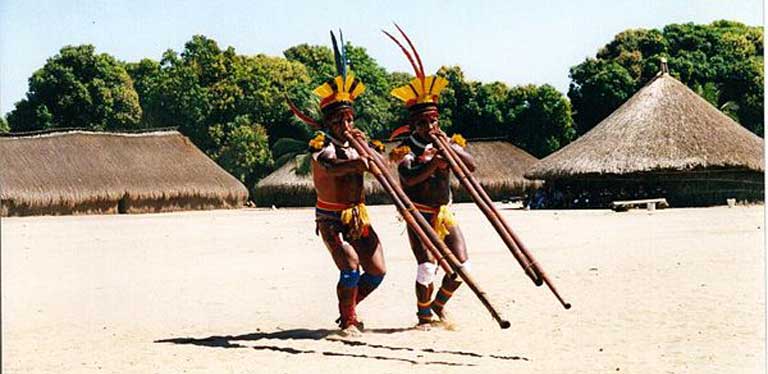
by DGR Colorado Plateau | Jan 2, 2016 | Colonialism & Conquest, Lobbying
By Sue Branford / Mongabay
Featured image courtesy of Wikipedia under the terms of the GNU Free Documentation License, Version 1.2
- Brazil’s Federal Public Ministry (MPF) has found the Brazilian federal government and the Norte Energia company guilty of ethnocide for the social and cultural destruction wrought on seven indigenous groups during the Belo Monte dam’s construction.
- The MPF is demanding the courts set up an external commission to prevent future harm, even as the Brazilian government is granted an operational licence for the dam, whose reservoirs are now filling.
- The MPF report states: “What is happening with the Belo Monte dam is a process of ethnic extermination by which the federal government is continuing with the colonial practice of integrating Indians into the hegemonic society.”
Brazil’s Public Federal Ministry (Ministério Público Federal, MPF), an independent state body, has started legal proceedings to have it recognised that the crime of “ethnocide” was committed on seven indigenous groups due to the severe detrimental impacts on their lives made by the building of the giant Belo Monte hydroelectric power station that will soon begin operating on the Xingu River in eastern Amazonia. The charges have been made against Brazil’s federal government and Norte Energia, the contractor that built the dam.
After carrying out a lengthy study that fills 50 books and includes contributions from a wide range of experts, the MPF has concluded that the “social organization, customs, languages and traditions” of the indigenous groups have been destroyed by the construction of the dam.
One of the actions undertaken by Norte Energia about which the MPF is most critical was a plan called “Plano Emergencial”. Under this plan the company set up a distribution center in Altamira, a town that has experienced explosive growth recently as a result of the dam’s construction. Goods and foodstuffs were available here each month for every indigenous village but the Indians had to travel to the town to pick them up. The money for the center came from a budget line for “ethno-development”, which was set up to help the villages become sustainable in food and to develop viable economic activities.
Indians, some of whom had never been to Altamira before, had to stop planting and fishing in order to travel to the town each month. The journey could take days and the whole procedure was very damaging to indigenous culture. The MPF says: “The villages became covered in garbage, with a proliferation of disease as a result, illnesses such as high blood pressure, obesity and diabetes became common because of the change in diet, child mortality surged, along with alcoholism, drug consumption and prostitution.”

The Belo Monte dam was completed at the cost of ethnocide to seven Amazon indigenous groups, according to the MPF. Photo by Pascalg622 licensed under under the terms of the GNU Free Documentation License, Version 1.2
At the same time Norte Energia began to build cheap houses in villages higher up the Xingu River, without taking into account indigenous culture. “Dozens of houses were built — wooden shacks with fiber cement roofs, like those in urban shanty-towns — with no consultation with Funai [the Indian Agency] or Ibama [the Environmental Agency]”. The building work itself was very harmful: unskilled workers without proper authorization entered the villages, disrupting village life and leaving construction waste behind; timber was illegally felled; a 17-year-old indigenous girl became pregnant from a construction worker.
Partially republished with permission of Mongabay. Read the full article, Brazil’s government charged with ethnocide in building of Amazon dam
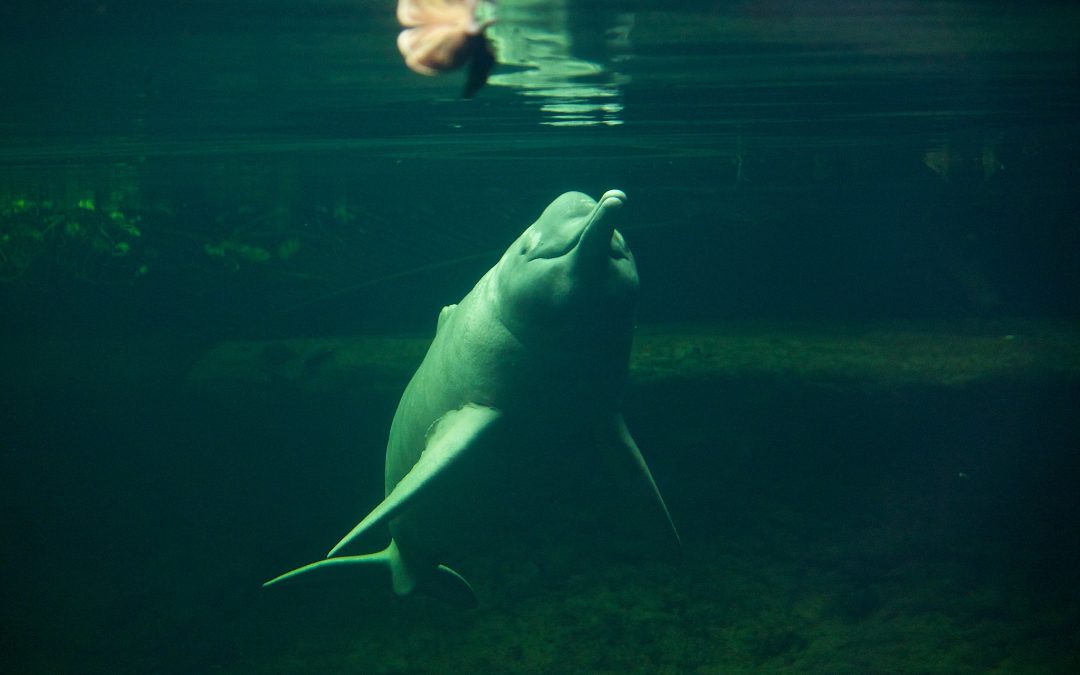
by DGR Colorado Plateau | Dec 22, 2015 | Biodiversity & Habitat Destruction, NEWS
By Claire Salisbury / Mongabay
- A new study finds that as many as 26 dams could put the charismatic Amazon River Dolphin and the freshwater Tucuxi Dolphin at risk.
- The research looked at whether particular Amazon dam projects would fragment dolphin populations and affect prey populations.
- Though the public is fascinated by the Amazon’s dolphins, no one knows how many are currently left in the wild, or how the dam building frenzy will impact their numbers.
A dam-building boom is underway in the Amazon. More than 400 hydroelectric dams are in operation, being built, or planned for the river’s headwaters and basin. Scientists know that tropical dams disrupt water flow and nutrient deposition, with negative consequences for aquatic animals, especially migratory species. But little detailed knowledge exists as to the impacts of dams on specific species, or as to the best mitigations to prevent harm.
A recent study that tries to fill in that knowledge gap zeroes in on Brazil’s river dolphins. It found that as many as 26 dams could negatively impact dolphin populations and their prey.
The research, led by Dr Claryana Araújo of the Federal University of Goiás, Brazil, focused on two freshwater species: the Amazon River Dolphin, or boto (Inia geoffrensis), which is sometimes famously pink; and the Tucuxi (Sotalia fluviatilis).
The river dolphins of South America are charismatic emblems of rainforest biodiversity, and have captured the public imagination. Swimming in rivers, lagoons, and among submerged tree trunks in flooded forests to chase down prey, they can be found as far inland as the upper reaches of Amazonian tributaries, more than 2,600 kilometers (1,615 miles) from the Atlantic Ocean.
The two species inhabit Brazil, Peru, Ecuador, and Colombia, and in the case of the Amazon River Dolphin, Bolivia and Venezuela. Their ranges in Brazil extend beyond the limits of the Amazon basin, to include the Araguaia-Tocantins (for the Amazon River Dolphin) and North Atlantic watersheds (for both species).
Despite their status as flagship species in the region, both are classified as Data Deficient by the International Union for Conservation of Nature (IUCN) due to a current dearth of data. No one knows how many exist in the wild, or population trends over recent decades, and uncertainties remain regarding their ecology, and major threats to the species. This lack of baseline data leaves scientists and governments in the dark regarding the conservation measures needed, and puts the animals at greater risk.
Partially republished with permission of Mongabay. Read the full article, Damming the Amazon: new hydropower projects put river dolphins at risk
“Amazon river dolphin” by Missud is licensed under CC BY-NC-ND 2.0.

by DGR Colorado Plateau | Dec 6, 2015 | Lobbying
By Big Island Video News
MAUNA KEA, Hawaii – The permit allowing the Thirty Meter Telescope to be built and operated on Mauna Kea has been thrown out by the Hawaii Supreme Court.
In the conclusion of a 58 page opinion written by Chief Justice Mark E. Recktenwald, the court vacated the lower circuit court’s “May 5, 2014 Decision and Order Affirming Board of Land and Natural Resources, State of Hawaii’s Findings of Fact, Conclusions of Law and Decision and Order Granting Conservation District Use Permit for the Thirty Meter Telescope at the Mauna Kea Science Reserve Dated April 12, 2013, and final judgment thereon.” The Supreme Court remanded the matter to the circuit court “to further remand to BLNR for proceedings consistent with this opinion, so that a contested case hearing can be conducted before the Board or a new hearing officer, or for other proceedings consistent with this opinion.”
As many predicted after hearing the court’s questions during the oral arguments presented on August 27 (video below), the court found that the Board of Land and Natural Resources “acted improperly when it issued the permit prior to holding a contested case hearing.” The court says BLNR’s February 25, 2011 approval violated Hawaii’s constitutional guarantee of due process.
Read more at Big Island Video News, and at Nature.com. DGR member Will Falk worked on the Mauna Kea campaign and published a series of essays of the TMT project; you can find them at Deep Green Resistance Hawaii.
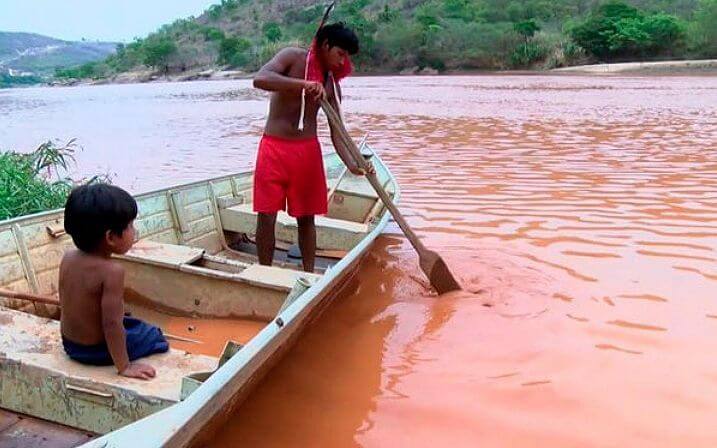
by DGR Colorado Plateau | Dec 3, 2015 | Biodiversity & Habitat Destruction, Indigenous Autonomy
by Marcela Belchior / Adital via Intercontinental Cry
What would initially appear to be the end of the line for the culture and survival of the Krenak indigenous people, impacted by the pollution of the Rio Doce, from the Mariana tragedy, in southeastern Brazil [state of Minas Gerais], could rekindle a 25 year struggle. After being left unable to live without the water of the river, the Krenak population is mobilized around a possible solution for the continuity of the community: to expand the demarcated area of the indigenous territory in the region and to migrate to a new location.
In an interview with Adital, Eduardo Cerqueira, member of the Indigenist Missionary Council (CIMI), Eastern Regional office, which comprises the states of Minas Gerais, Espírito Santo and the extreme south of Bahia, affirms that, as a way to resist the tragedy, the Krenak community [is calling] on the federal government to expand the demarcated area into 12,000 adjacent hectares, embracing the region where the State Park of Sete Salões, one of the Units of Conservation of nature belonging to the Government of Minas Gerais, is currently located.
“We find the strategy interesting, given that the existing area no longer provides conditions for survival. Something must be done”, attests Cerqueira. At present, the demarcated area of Krenak territory covers 4700 hectares. In this zone, extending more than three kilometers along the Doce River have been impacted and rendered unfit for drinking, fishing, bathing and irrigating vegetation in the vicinity, in the municipality of Resplendor, where 126 Krenak families live.
The State Park Parque de Sete Salões was created in 1998, and includes the municipalities of Conselheiro Pena, Itueta and Santa Rita do Itueto, corresponding to one of the largest remnants of Atlantic Forest in eastern Minas Gerais, with mountains, forests and waterfalls. Besides this, the area demanded has potential for indigenous community tourism, receiving visitors and marketing crafts, without damage to the environment.
The territory of the Krenak population, in Minas Gerais, was demarcated in the 1990s, but the entire length of the park was excluded, which today could once again be placed on the agenda. In the early 2000s, the Indigenous people filed a claim with the National Indian Foundation (Funai) and the federal government conducted a technical study on the matter, which to date has not been published. In the opinion of the Krenak, now, the situation is more than appropriate to fulfill the historical demand of the population.
“Various indigenous leaders are concerned about the territorial question. Now, it is a matter of necessity for this concern to be the focus of discussion. (…) This part of the region was not affected by the tailings [pollution],” defends the indigenous advocate. According to the CIMI counselor, since the socioenvironmental tragedy, the indigenous peoples affected have been assisted with emergency support, by means of tank trucks supplying water, transfer of basic food baskets and financial support for the families, which would ensure the community’s survival only in the short term.
“This tragedy was intensified by a period of severe drought. For over a year there has been no rain in the region. Because of this, the tributaries of the Rio Doce are dry. (…) The terrain is not favorable to agriculture. Livestock would be the most common form of indigenous survival, but it is not possible, without water,” explains Cerqueira.
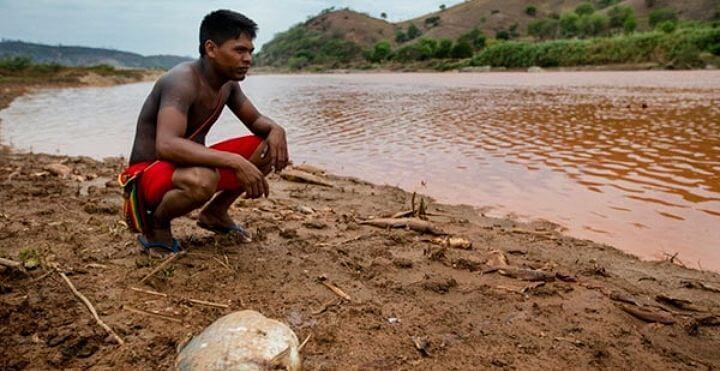
Geovani Krenak laments the death of the Rio Doce: “we are one, people and nature, only one,” he says. Photo: Reproduction.
UNDERSTANDING THE CASE
A torrent of mud composed of mining tailings (residual waste, impurities and [chemical] material used for flushing out minerals) has been flooding the 800 kilometer length of the Rio Doce since November 5, after the rupture of the Fundão dam, of the Samarco mining company. This is controlled by Vale, responsible for innumerable and grave socioenvironmental damages in Brazil, and the multinational Anglo-Australian BHP Billiton, two of the largest mining companies in the world.
In addition to burying an entire district, impacting several others and polluting the Rio Doce, extending through the states of Minas Gerais, Espírito Santo and Bahia, the mud reached the sea over the weekend, even further amplifying the environmental damage, which could take more than two decades before signs of recovery even begin to present. In addition to the destruction of fauna and flora, seven deaths and 17 disappearances have so far been recorded.
KRENAK PEOPLE CLOSE ROAD IN PROTEST
Early last week, representatives of the Krenak indigenous people, whose tribe is situated on the banks of the Rio Doce, interrupted, in protest, the Vitória-Minas Railroad. Without water for more than a week, they said they would leave only when those responsible for the tragedy talk with them. “They destroyed our lives, they razed our culture and ignore us. This we do not accept,” asserted Aiah Krenak to the press.
Considered sacred, in a culture whose cosmological worldview is based on the interconnection between all beings – humans, plants, animals, etc., the river that flows through the tribe was utilized by 350 Indians, for consumption, bathing and cleansing. “With the people, this is not separate from us, the river, trees, the creatures. We are one, people and nature, only one”, says Geovani Krenak.
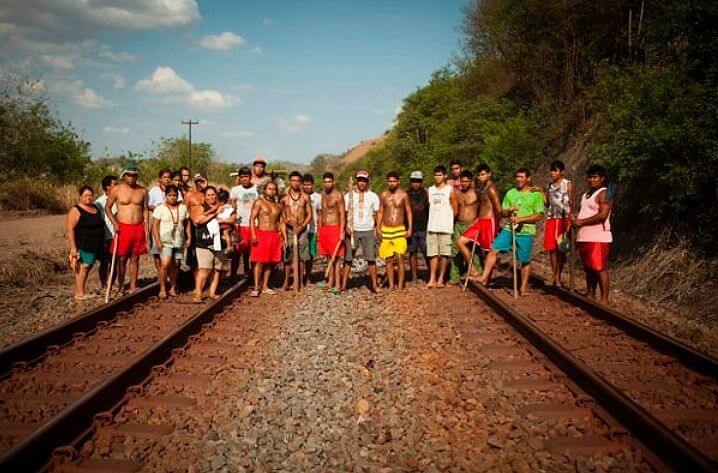
Krenak people protest on the Vitória-Minas Railroad. Photo: Reproduction.
Seated along the tracks, under a 41C. degree sun, Indians chanted music in gratitude to the river, in the Krenak language. “The river is beautiful. Thank you, God, for the river that feeds and bathes us. “The river is beautiful. Thank you, God, for our river, the river of all of us,” the words of shaman Ernani Krenak, 105 years of age, translated for the press.
His sister, Dekanira Krenak, 65 years old, is attentive to the impact of the death of the river affecting not only the indigenous peoples, being a source of resources for many communities. “It is not ‘us alone’, the whites who live on the riverbank are also in great need of this water, they coexist with this water, many fishermen [feed their] family with the fishes,” she points out.
Camped on site in tarpaulin shacks and sleeping mats in the open air, the Indians, now, must also face an unbearable swarm of insects. “It was never like this,” says Geovani Krenak. “These mosquitoes came with the polluted water, with fish that once fed us and that are now descending the river, dead, he reports.
Article originally published in Portuguese at
Adital. Translated to English for Intercontinental Cry by M.A. Kidd. Republished with permission of Intercontinental Cry.







